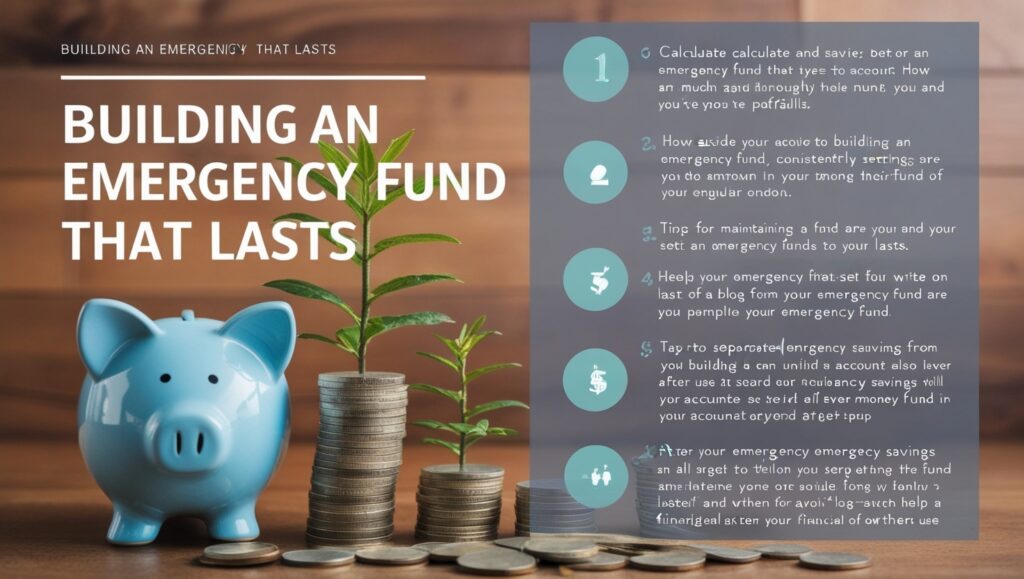How to Build an Emergency Fund That Lasts
Life is unpredictable, and financial emergencies can strike when you least expect them. Whether it’s a sudden job loss, medical expenses, car repairs, or unforeseen home maintenance, having a solid emergency fund can act as a safety net, providing financial stability and peace of mind during tough times.
Building an emergency fund that lasts requires planning, discipline, and a strategic approach. This guide will walk you through the steps to create and maintain a robust financial cushion.
Why You Need an Emergency Fund
An emergency fund is essential for financial security. Here’s why:
Protects Long-Term Goals: Emergency funds prevent you from dipping into savings or investments meant for retirement or other goals.
Reduces Stress: Knowing you have money set aside for unexpected events can alleviate financial anxiety.
Avoids Debt: With a financial cushion, you’re less likely to rely on credit cards or loans during emergencies.
How Much Should You Save?
The amount you need in an emergency fund depends on your lifestyle, monthly expenses, and financial responsibilities.
- Basic Rule of Thumb: Save 3–6 months’ worth of essential living expenses.
- For Families: Aim for 6–12 months of expenses, especially if you have dependents.
- For Freelancers or Business Owners: Consider saving closer to 9–12 months, as income may be less predictable.
Steps to Build an Emergency Fund
1. Assess Your Finances
- Calculate your monthly expenses, including rent, utilities, groceries, insurance, and loan payments.
- Identify discretionary spending that can be minimized to boost savings.
2. Set a Realistic Goal
- Start small if saving several months of expenses feels overwhelming. For example, aim for $500–$1,000 initially, then build from there.
3. Create a Dedicated Savings Account
- Open a separate savings account specifically for your emergency fund to avoid spending it accidentally.
- Consider high-yield savings accounts to earn more interest on your money.
4. Automate Your Savings
- Set up automatic transfers from your checking account to your emergency fund. Even small, consistent contributions add up over time.
- For example, saving $50 weekly can accumulate $2,600 in a year.
5. Cut Unnecessary Expenses
- Review subscriptions, dining out habits, and impulse purchases. Redirect these funds into your emergency savings.
- Consider temporary lifestyle adjustments, like cooking at home or delaying non-essential purchases.
6. Boost Your Income
- Take on a side hustle or freelance work to supplement your income.
- Sell unused items online or in a yard sale to generate extra cash.
7. Use Windfalls Wisely
- Allocate tax refunds, work bonuses, or monetary gifts directly to your emergency fund.
Maintaining Your Emergency Fund
Once you’ve built your emergency fund, it’s equally important to maintain it:
- Replenish After Use: If you dip into your emergency fund, prioritize refilling it as soon as possible.
- Review Regularly: Periodically reassess your savings goal to account for changes in expenses or life circumstances.
- Protect It: Avoid using the fund for non-emergencies. Stick to your rule: only for unexpected, necessary expenses.
Where to Keep Your Emergency Fund
Accessibility and safety are key considerations:
- High-Yield Savings Accounts: Offer higher interest rates than standard accounts while keeping funds liquid.
- Money Market Accounts: Combine the benefits of savings and checking accounts, allowing limited withdrawals.
- Avoid Risky Investments: Don’t keep emergency funds in stocks or mutual funds; market volatility could reduce their value.
Common Mistakes to Avoid
- Underestimating Expenses: Failing to account for all essential costs can leave your fund short.
- Dipping Into the Fund for Non-Essentials: Treat your emergency fund as untouchable for anything other than true emergencies.
- Neglecting Regular Contributions: Inconsistent saving can stall your progress. Automating deposits helps ensure steady growth.
The Emotional and Financial Benefits of an Emergency Fund
An emergency fund does more than protect your finances; it also fosters a sense of security and control over your life. With this safety net, you’ll face unexpected challenges with confidence, knowing you’ve prepared for the worst.
Final Thoughts
Building an emergency fund that lasts isn’t about overnight success—it’s about consistent, thoughtful steps toward financial security. Begin with a manageable goal, build steadily, and prioritize maintaining your fund once it’s established.
Remember, the best time to start is now. Each dollar you save today brings you closer to a more secure and stress-free future.
What strategies have helped you save for emergencies? Share your tips and experiences in the comments below!

